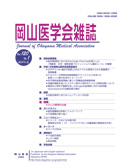

Journal of Okayama Medical Association
Published by Okayama Medical Association<Availability>
Full-text articles are available 3 years after publication.
Permalink : http://escholarship.lib.okayama-u.ac.jp/16507
Detection of antibodies to denatured DNA by radioimmunoassay Part I: Comparison of methods
Sarai, Tetsuo
Published Date
1981-02-28
Abstract
(14)C•denatured(d-) DNA, (125)I•d-DNA and (3)H•Actinomycin D•d-DNA were used as radioabelled DNA antigens for radioimmunoassay of antibody to d-DNA. The (14)C-DNA derived rom E. Coli was the most suitable antigen for simultaneous detection of antibodies to native n-) DNA and d-DNA. (125)I•d-DNA was easily prepared by iodination of heat denatured alf thymus DNA in vitro. (3)H•Actinomycin D•d-DNA was also easily prepared by mixing I-DNA with (3)H•Actinomycin D in vitro. Using normal human sera and systemic lupus eryhematosus (SLE) sera that had contained antibody to d-DNA, half saturated ammonium sulfate method and filter method were employed to separate immunoglobulin-bound antigen from free antigen. To avoid nonimmunological bindings to d-DNA, pH and ionic strength of assay system were determined as 8.3 and 0.15 respectively. In the filter method, application of sonication to radiolabelled d-DNA prevented nonspecific binding of the antigen to the filter nembrane. However, in the half saturated ammonium sulfate method, d-DNA binding between SLE sera and sonicated radiolabelled d-DNA decreased markedly. When (3)H•Actinomycin D•d-DNA was the antigen, neither the half saturated ammonium sulfate method nor the filter method was suitable for evaluation of antibody to d-DNA. There was fairly good correlation between the half saturated ammonium sulfate method and the filter method, using either (14)C•d-DNA or (125)I•d-DNA as the antigen. The half saturated ammonium sulfate method and the filter method were reproducible, quantitative, sensitive and specific enough to detect antibody to d-DNA.
ISSN
0030-1558
NCID
AN00032489
